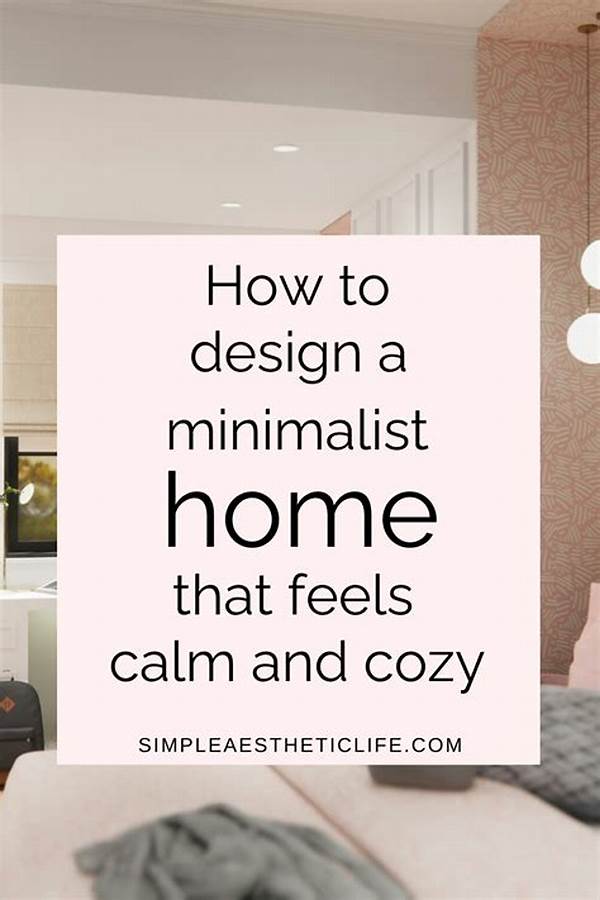In a world bustling with chaos and overstimulation, finding a tranquil space becomes a luxury that not everyone can afford. The secret sauce to achieving this haven of tranquility might just be minimalist design. Inspired by the philosophy of “less is more,” minimalist design focuses on simplicity, reducing clutter, and using strategic elements to craft spaces that breathe serenity and functionality. With the rise of digital noise and the constant influx of information from all sides, people are eager to retreat to environments that ease the mind and calm the soul. It’s akin to sipping a cup of tea in a storm, finding solace amidst the whirlwind of life.
Read More : Minimalism In Tropical Homes: Keeping It Cool And Airy
The charm of minimalist design isn’t just in its aesthetic appeal, but also in its ability to transform any space into a sanctuary of peace. Imagine stepping into a room stripped of all excess, where each piece holds value and purpose. It’s not about having an empty, sterile environment; rather, it’s about balancing the elements to ensure that every aspect contributes to a restful ambiance. The use of neutral colors, clean lines, and functional furniture opens up spaces, allowing them to be both inviting and refreshing.
Understanding Minimalism in Design
Minimalism is more than just a trend; it’s a lifestyle choice. By focusing on essentials, you not only declutter your space but also your mind. It allows individuals to live with less distraction, encouraging mindfulness and intentionality in everyday decisions. While many might associate minimalism with stark, boring settings, it offers vast opportunities for personalization. The key is achieving harmony between simplicity and functionality. So, how do you create visual calm with minimalist design?
Firstly, embrace neutral color palettes. Whites, grays, and earth tones are fundamental to minimalism, as they provide a backdrop that encourages relaxation. Textures also play a crucial role. Incorporating natural materials like wood or stone can add warmth to the space, ensuring it doesn’t feel cold or unwelcoming. Secondly, strategic lighting can elevate or diminish the mood of a room, so it’s pivotal to consider how light interacts with your space.
How Minimalist Design Promotes Serenity
Now that you understand the foundational principles of minimalist design, let’s dive deeper into how this approach fosters a sense of calm. One of the standout features of minimalist spaces is their ability to exude tranquility instantly. By cutting down on visual noise, minimalist design focuses the attention on what truly matters—creating a setting that encourages relaxation and solace.
But the true magic lies not just in removing clutter but in thoughtfully organizing it to enhance flow and purpose. When done right, minimalist interiors guide the eye through a series of open, cohesive areas that promote ease and clarity in daily life. Beyond aesthetic, the minimalistic approach nurtures a mindful lifestyle, where every piece serves a purpose or sparks joy. Living in such a space means perpetually being surrounded by tranquility, having a direct positive effect on one’s mindset and lifestyle—simplifying not only environments but also the way individuals interact within their spaces, making it an essential strategy for a calm and peaceful existence.
—
As the pace of life quickens, the art of creating spaces that evoke calmness and ease becomes a skill in high demand. Enter minimalist design, the perfect blend of art and science that not only appeals aesthetically but also psychologically. This approach to interior design isn’t just a creative endeavor but a well-thought-out strategy that caters to the human yearning for simplicity and clarity.
One of the strongest advocates for minimalist design is its psychological benefits. Research has shown that cluttered environments can lead to increased levels of stress and anxiety, while minimalism encourages clarity and focus. By eliminating unnecessary items and distractions, minimalist spaces provide a clean slate for productivity and relaxation. The formula is simple: integrate functionality, simplicity, and elegance, and you’ve got a recipe for a visually calming space.
Balancing Aesthetic and Functionality
But how exactly does one strike a balance between aesthetic appeal and functionality? The secret lies in choosing pieces that serve dual purposes. Furniture that doubles up as storage or decorative elements that have functional uses are excellent examples of combining beauty and practicality. The aim here isn’t to sacrifice comfort for the sake of art but to consider every piece’s role in contributing to the overall harmony of the space.
While some might perceive minimalist design as a cold or stark approach, it paradoxically creates warmth through careful selection and placement. Each element reflects mindfulness and intentionality, transforming spaces into experiences of sensory relaxation. Natural light plays a vital role here. Large windows that allow streams of light to pour in and illuminate strategically placed furnishings add to the visual calm that minimalist design seeks to achieve.
Engaging the Senses with Minimalism
A minimalist space isn’t only about what you see but what you feel, touch, and experience. The textures of the materials used—like the grain of natural wood or the softness of textiles—invite individuals to engage their senses in a subtle, undemanding manner. Ultimately, it’s about creating a holistic experience that grounds inhabitants, allowing them to disconnect from the chaos of the outside world.
In practice, minimalist design demands a discerning eye. It’s about choosing pieces that speak to the individual while adhering to the principles of less-is-more. The intention is to craft environments that communicate calm without compromising personal style—spaces that whisper serenity through intentional choices and refused necessities. The charm of how to create visual calm with minimalist design lies in its simplicity, appealing to human instincts that seek order amidst chaos.
Minimalist design serves more than just an aesthetic function; it inspires a reevaluation of life choices. This design ethos prompts individuals to consider where value truly lies and how surroundings impact emotional and physical well-being. Once you grasp how to create visual calm with minimalist design, you’ll revel in the beauty of spaces that echo serenity and embrace mindful living.
—
Key Takeaways on Minimalist Design
The Purpose and Benefits of Minimalist Design
Minimalist design is not merely an aesthetic journey; it’s an invitation to embrace a lifestyle centered around mindfulness, simplicity, and purpose. As we delve into the core of what minimalist design embodies, we find that it touches on deeper human desires for balance, clarity, and peace. Every choice made, from the furniture selected to the color palettes employed, communicates an intentional move towards creating spaces that provide refuge from a hectic world. But why is this design philosophy gaining ground, and how does it tangibly improve our lives?
Purpose Beyond Aesthetics
The primary purpose of minimalist design is to strip away the unnecessary, enabling individuals to focus on what truly matters. This is not just about removing physical clutter but about encouraging a decluttering of the mind. By cultivating spaces that are easy to manage, minimalist design allows individuals to devote time and energy to pursuits that bring them joy and fulfillment. It’s about creating an environment that supports rather than detracts from life’s experiences.
Moreover, the design aims to improve the quality of life by offering spaces that enhance relaxation, encourage mindfulness, and reduce stress. Through this approach, how to create visual calm with minimalist design is not just a question of aesthetics but a pathway to improved mental health and well-being. As spaces become reflections of intentional living, occupants inevitably find themselves living more mindfully, valuing every element, and enjoying the freedom that comes with owning less yet experiencing more.
Minimalism, while visually straightforward, requires thoughtful execution to truly achieve a visually calming effect. When considering how to create visual calm with minimalist design, one must first observe the space as a blank canvas—a starting point where every addition is deliberate and essential.
It starts with a palette: serene, neutral, and timeless. Whites, taupes, and subtle greys lay the foundation for a minimalist approach, offering a muted backdrop against which every other design element stands out with clarity. This color choice isn’t merely an aesthetic decision but a psychological one. Research suggests that neutral tones can positively influence mood, providing a calm and collected atmosphere that rejuvenates the spirit.
Unearth the value of open spaces. Minimalist design thrives on maximizing openness, allowing rooms to flow seamlessly from one to the next. This is where a clever layout comes into play—think of furniture not as mere items, but as elements that dictate movement and interaction within a space. Opt for multifunctional pieces that offer storage, comfort, and clean lines, further decluttering visual space and promoting ease.
Lighting—both natural and artificial—plays a pivotal role in achieving the desired tranquility. Light fixtures should complement the minimalist ethos, with designs that are elegant yet understated. Strategically placed to cast soft, welcoming glows, lighting becomes an art form in itself, creating ambiance without overshadowing the simplicity of the design. Remember, how you position lighting can alter a room’s dynamic, turning it from stark to serene with the flick of a switch.
Simplifying Space for Maximum Impact
When embracing minimalist design, less truly becomes more. Embrace the beauty of fewer, but purposeful, decor elements. A single piece of art, a beautiful plant, or a tastefully designed chair is more impactful than multiple items competing for attention. These choices not only maintain the focus but also give each item the space needed to resonate, each telling its own story without vying for dominance.
Let’s not forget the importance of textures. While minimalist design champions simplicity, it should not translate to flatness. Incorporating various textures adds depth and interest, ensuring the space remains inviting and warm rather than sterile. Think woven fabrics, matte finishes, and natural fibers to evoke a tactile sense of comfort and homeliness.
Establishing visual calm goes beyond removing excess; it’s about cultivating spaces of authenticity and purpose. By adhering to these principles, you not only appreciate the elegance of simplicity but also learn how to create visual calm with minimalist design—spaces that soothe the senses while fostering creativity and introspection.
—
—
Crafting a Minimalist Atmosphere
Creating a minimalist space is an art that fuses functionality and elegance with the aspiration of achieving a peaceful atmosphere. It’s not merely about stripping down to essentials but about emphasizing the beauty of simplicity. At its core, minimalist design teaches the appreciation of quality over quantity, transforming houses into sanctuaries where individuals can truly unwind.
However, the allure of minimalism goes beyond aesthetics. It’s a lifestyle that resonates with the modern need for clarity amidst chaos. By learning how to create visual calm with minimalist design, you embark on a transformative journey that not only enhances your living space but also the way you engage with your surroundings. As you phase out excess and embrace simplicity, you’ll find that the principles of minimalist design offer not just a visual treat but a route to a mindful and intentional way of living.
Balancing Form and Function
The success of minimalist design lies in the balance between form and function, where each piece serves a purpose while harmoniously integrating with the overall aesthetic. By investing in versatile furniture and focusing on essential pieces, you lay the groundwork for a space that feels both complete and effortlessly chic. In doing so, you establish a living environment that welcomes you with open arms—a sanctuary in every sense of the word.
Ultimately, minimalist design is less about saying goodbye to things and more about welcoming peace and purpose into your life. As you immerse yourself in this transformative approach, you’ll uncover the true essence of spatial harmony and personal satisfaction—discovering how to create visual calm with minimalist design is just the beginning of an enriching journey toward a more intentional living space.
—
Minimalism isn’t accidental—it’s a deliberate choice advocating for simplicity and functionality. By incorporating the principles of minimalist design into your home or workspace, you are not just engaging in a stylistic choice but embracing a lifestyle that values balance, elegance, and serenity. These calculated decisions lead to spaces that are as functional as they are beautiful, embodying a sense of tranquility that complements the rhythm of modern life.
The first step in crafting a minimalist space is to evaluate existing elements and determine which ones serve a purpose. It necessitates a discerning eye and a willingness to let go of items that distract from the overall vision. By doing so, you will clear physical and mental space for more pertinent or meaningful experiences.
Another vital aspect is the use of negative space. Rather than filling every corner, embrace emptiness as a design element that accentuates other features in the room. This orchestrated balance lends an air of elegance, drawing focus to focal points without overwhelming the senses. Simplicity, when executed with purpose, can be visually striking and infinitely calming—a testament to how to create visual calm with minimalist design.
—
These approaches and insights are stepping stones toward embracing minimalism in your living or workspaces. As you integrate these strategies, you will undoubtedly discover a newfound appreciation for how thoughtful design choices promote a lifestyle of intention and focus.


